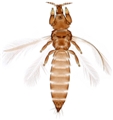Arorathrips mexicanus
Recognition data
Distinguishing features
Female fully winged but male wingless. Mature females dark brown although recently emerged individuals are bicolored. Antennae 8-segmented, segments III � IV with simple sensorium stout; segment II prolonged externally with terminal sensorium. Head small, projecting in front of eyes, vertex with about 3 pairs of setae. Pronotum trapezoidal, 2 pairs of prominent posteroangular setae. Fore coxae enlarged and transverse, fore femora swollen, fore tibia extending around external margin of fore tarsus. Meso and metafurca weakly developed. Forewing slender, apex pointed, first vein with 3 setae distally, second vein with 3 to 4 widely spaced setae. Tergites with transverse sculpture lines medially; antecostal ridge of tergites II � V with row of small tubercles; craspedum complete on I � VIII. Ovipositor weak, without teeth. Sternites II � IV medially with pattern of tubercles. Male wingless, yellow; sternites III � VII medially with large circular glandular area.
Related and similar species
The genus Arorathrips comprises about 13 New World species (Mound & Marullo, 1996). These all differ from the members of Chirothrips in having the mesothoracic endofurca greatly reduced. A. mexicanus is closely related to A. crassiscelis Strassen that is presumed to have come from Argentina and has a larger number of setae on the head.
Taxonomic data
Current valid name
Arorathrips mexicanus (Crawford DL)
Original name and synonyms
Chirothrips mexicanus Crawford DL, 1909: 114
Chirothrips floridensis Watson, 1920: 22
Chirothrips catchingsi Watson, 1924: 76
Chirothrips saltensis Tapia, 1952: 109
Family placement
Thripidae, Thripinae
Biological data
Life history
Breeding within individual florets of various Poaceae.
Host plants
Recorded from many different grasses, but with no recorded specificity.
Tospoviruses vectored
None
Crop damage
None recorded.
Distribution data
Area of origin
Probably South America
Distribution
Widespread throughout the world in tropical countries.










